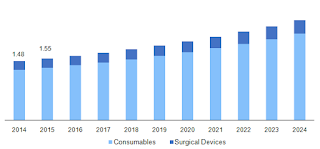The global Hernia Repair Market is expected to reach USD 6.60
billion by 2024. Rigorous research & development activities, growing number
of obese patients and high susceptibility of geriatric patients to suffer from
hernia are expected to drive the market over the forecast period. Increasing
technological sophistication in repair devices and rigorous research and
development of the drug-eluting mesh is projected to boost the demand for
hernia repair devices and consumables.
Post-operative pain is growing concern post-repair with synthetic mesh. Though the cause of pain varies from patient to patient, a primary reason for pain is inflammation associated with the synthetic mesh. Other chronic illnesses related to the use of implanted mesh are abdominal pain, infection (sepsis), bowel obstruction and adhesion. In spite of increasing technological sophistication in mesh technology, synthetic materials remain the most widely used mesh products for hernia repair especially the polypropylene mesh due to their low cost and easy availability.
The biological mesh is gaining momentum in developed countries especially in the U.S. Biologic mesh development has overcome the problem associated the synthetic mesh including foreign body interaction, chronic inflammation, infection, and stiffness. Presence of favorable reimbursement policies coupled with the well-regulated healthcare insurance and increasing prevalence of an inguinal and ventral hernia in developed economies have rendered increased acceptance of this product.
Browse Details of Report @ https://www.hexaresearch.com/research-report/hernia-repair-market
The above mentioned factors collectively boost demand for overall hernia repair consumables and surgical devices market over the forecast period. Owing to shortcomings of synthetic mesh, manufacturers are working on developing cost-effective and technological advanced mesh. For instance, Ariste Medical is developing drug-eluting mesh. These repair products are anticipated to improve the patient outcomes specifically in vascular procedures including hernia and peripheral bypass hemodialysis processes.
Also, manufacturers are focusing on developing composite or hybrid mesh. The hybrid mesh is a result of the combination of best features of biologic and synthetic mesh. Mesh that combines a minute quantity of synthetic material such as polypropylene and biologic building blocks derived from animal tissue has the property to diminish the hazards of inflammatory reactions along with providing long-term durability. Medtronic and COOK Medical are investing in the development of cost-effective composite mesh. This product may overcome the disadvantages associated with the synthetic mesh such as inflammation, sepsis and abdominal adhesion. These factors render cost advantage over the biologic mesh, which in turn is expected to boost the hernia repair market.
Hexa Research has segmented the global hernia repair market based on product, procedure, and region:
Segmentation by product, 2014 - 2024 (USD Million)
• Consumables
• Synthetic Mesh
• Biologic Mesh
• Surgical Devices
Segmentation by procedure, 2014 - 2024 (USD Million)
• Tension Free
• Open Hernia Repair
• Laparoscopic
Segmentation by region, 2014 - 2024 (USD Million)
• North America
• U.S.
• Europe
• Germany
• Asia Pacific
• China
• Central & South America
• Brazil
• Middle East & Africa
• UAE
Key players analyzed:
• Ethicon, Inc.
• Medtronic
• C. R. Bard
• Atrium
Browse Related Category Market Reports @ https://www.hexaresearch.com/research-category/medical-devices-industry
Post-operative pain is growing concern post-repair with synthetic mesh. Though the cause of pain varies from patient to patient, a primary reason for pain is inflammation associated with the synthetic mesh. Other chronic illnesses related to the use of implanted mesh are abdominal pain, infection (sepsis), bowel obstruction and adhesion. In spite of increasing technological sophistication in mesh technology, synthetic materials remain the most widely used mesh products for hernia repair especially the polypropylene mesh due to their low cost and easy availability.
The biological mesh is gaining momentum in developed countries especially in the U.S. Biologic mesh development has overcome the problem associated the synthetic mesh including foreign body interaction, chronic inflammation, infection, and stiffness. Presence of favorable reimbursement policies coupled with the well-regulated healthcare insurance and increasing prevalence of an inguinal and ventral hernia in developed economies have rendered increased acceptance of this product.
Browse Details of Report @ https://www.hexaresearch.com/research-report/hernia-repair-market
The above mentioned factors collectively boost demand for overall hernia repair consumables and surgical devices market over the forecast period. Owing to shortcomings of synthetic mesh, manufacturers are working on developing cost-effective and technological advanced mesh. For instance, Ariste Medical is developing drug-eluting mesh. These repair products are anticipated to improve the patient outcomes specifically in vascular procedures including hernia and peripheral bypass hemodialysis processes.
Also, manufacturers are focusing on developing composite or hybrid mesh. The hybrid mesh is a result of the combination of best features of biologic and synthetic mesh. Mesh that combines a minute quantity of synthetic material such as polypropylene and biologic building blocks derived from animal tissue has the property to diminish the hazards of inflammatory reactions along with providing long-term durability. Medtronic and COOK Medical are investing in the development of cost-effective composite mesh. This product may overcome the disadvantages associated with the synthetic mesh such as inflammation, sepsis and abdominal adhesion. These factors render cost advantage over the biologic mesh, which in turn is expected to boost the hernia repair market.
Hexa Research has segmented the global hernia repair market based on product, procedure, and region:
Segmentation by product, 2014 - 2024 (USD Million)
• Consumables
• Synthetic Mesh
• Biologic Mesh
• Surgical Devices
Segmentation by procedure, 2014 - 2024 (USD Million)
• Tension Free
• Open Hernia Repair
• Laparoscopic
Segmentation by region, 2014 - 2024 (USD Million)
• North America
• U.S.
• Europe
• Germany
• Asia Pacific
• China
• Central & South America
• Brazil
• Middle East & Africa
• UAE
Key players analyzed:
• Ethicon, Inc.
• Medtronic
• C. R. Bard
• Atrium
Browse Related Category Market Reports @ https://www.hexaresearch.com/research-category/medical-devices-industry


No comments:
Post a Comment